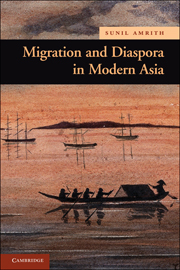Book contents
- Frontmatter
- Contents
- List of Plates, Tables, and Maps
- Acknowledgements
- Select Timeline
- Glossary
- Maps
- Introduction
- 1 Asia's Great Migrations, 1850–1930
- 2 The Making of Asian Diasporas, 1850–1930
- 3 War, Revolution, and Refugees, 1930–1950
- 4 Migration, Development, and the Asian City, 1950–1970
- 5 Asian Migrants in the Age of Globalization, 1970–2010
- Conclusion
- Guide to Further Reading
- Index
5 - Asian Migrants in the Age of Globalization, 1970–2010
Published online by Cambridge University Press: 05 June 2012
- Frontmatter
- Contents
- List of Plates, Tables, and Maps
- Acknowledgements
- Select Timeline
- Glossary
- Maps
- Introduction
- 1 Asia's Great Migrations, 1850–1930
- 2 The Making of Asian Diasporas, 1850–1930
- 3 War, Revolution, and Refugees, 1930–1950
- 4 Migration, Development, and the Asian City, 1950–1970
- 5 Asian Migrants in the Age of Globalization, 1970–2010
- Conclusion
- Guide to Further Reading
- Index
Summary
I'm thankful for my life as a migrant worker. It has given me the opportunity to make myself strong and it has taught me how to get on with others, and that if you try you can do anything. The long journey of the migrant worker presents even more opportunities than it does challenges. I wish all those who are working away from home more success and happiness and less unhappiness and worries. I wish that through their diligent work they will realize their dreams!
Wang Ziangfen, ‘Looking Back I am Proud’The 1970s marked another turning point in the history of migration in Asia. The balance of economic power within Asia began to shift, with the economic rise of East and Southeast Asia, and the growing power of the oil-producing nations of the Middle East. These economic transformations opened new frontiers of migration. As the post-colonial projects of national development began to falter, the international dimension of migration grew once again, facilitated by cheaper air travel and communications.
Asian migration in a global age continues to follow regional patterns, taking people from South Asia, Indonesia, and the Philippines to the growth economies of Southeast Asia (particularly Malaysia and Singapore), and to the Persian Gulf.
- Type
- Chapter
- Information
- Migration and Diaspora in Modern Asia , pp. 151 - 192Publisher: Cambridge University PressPrint publication year: 2011
- 1
- Cited by



